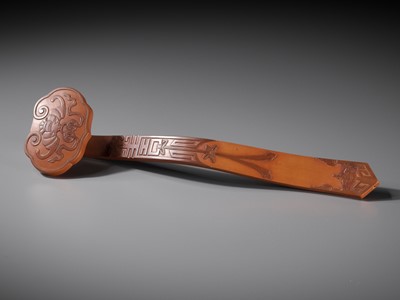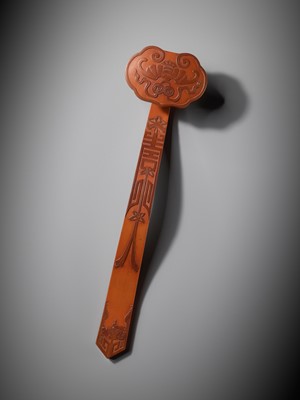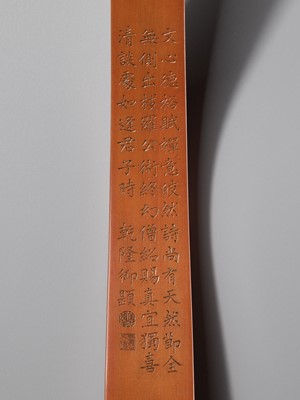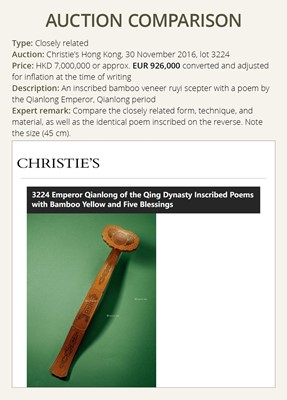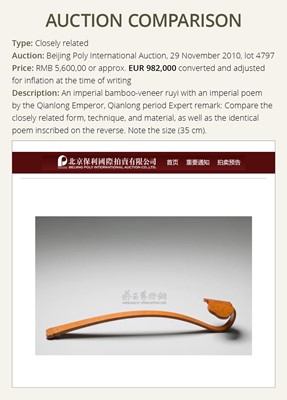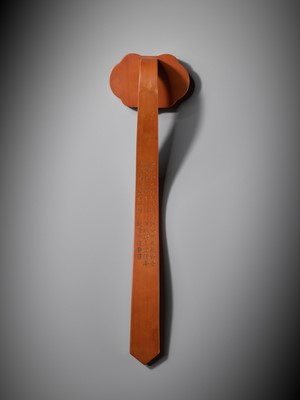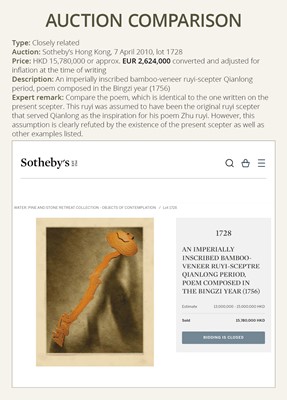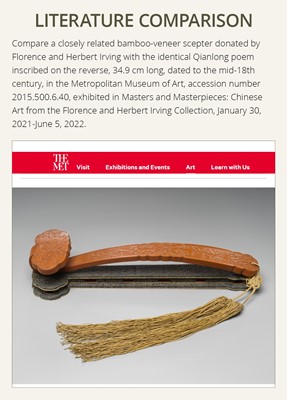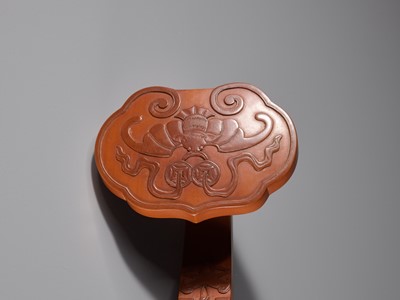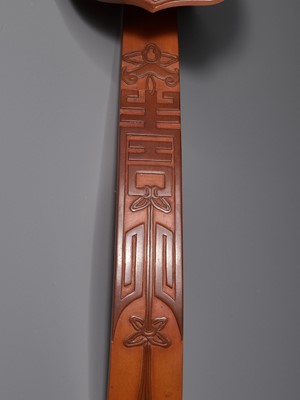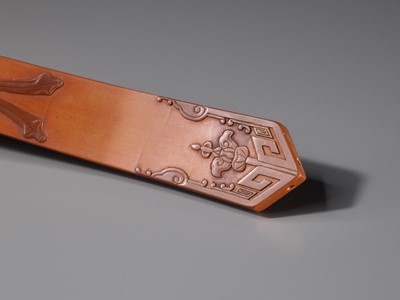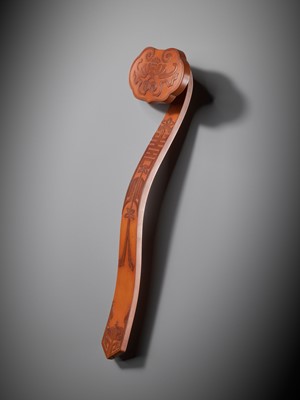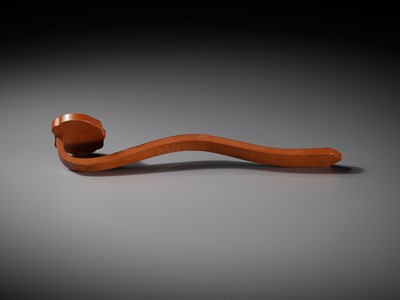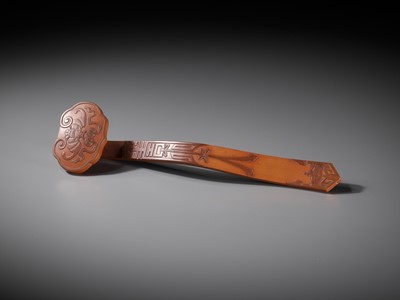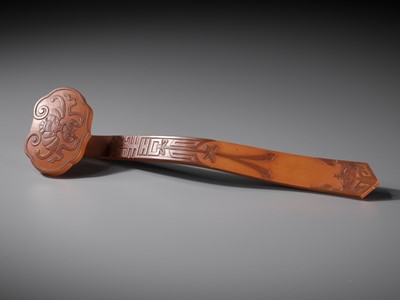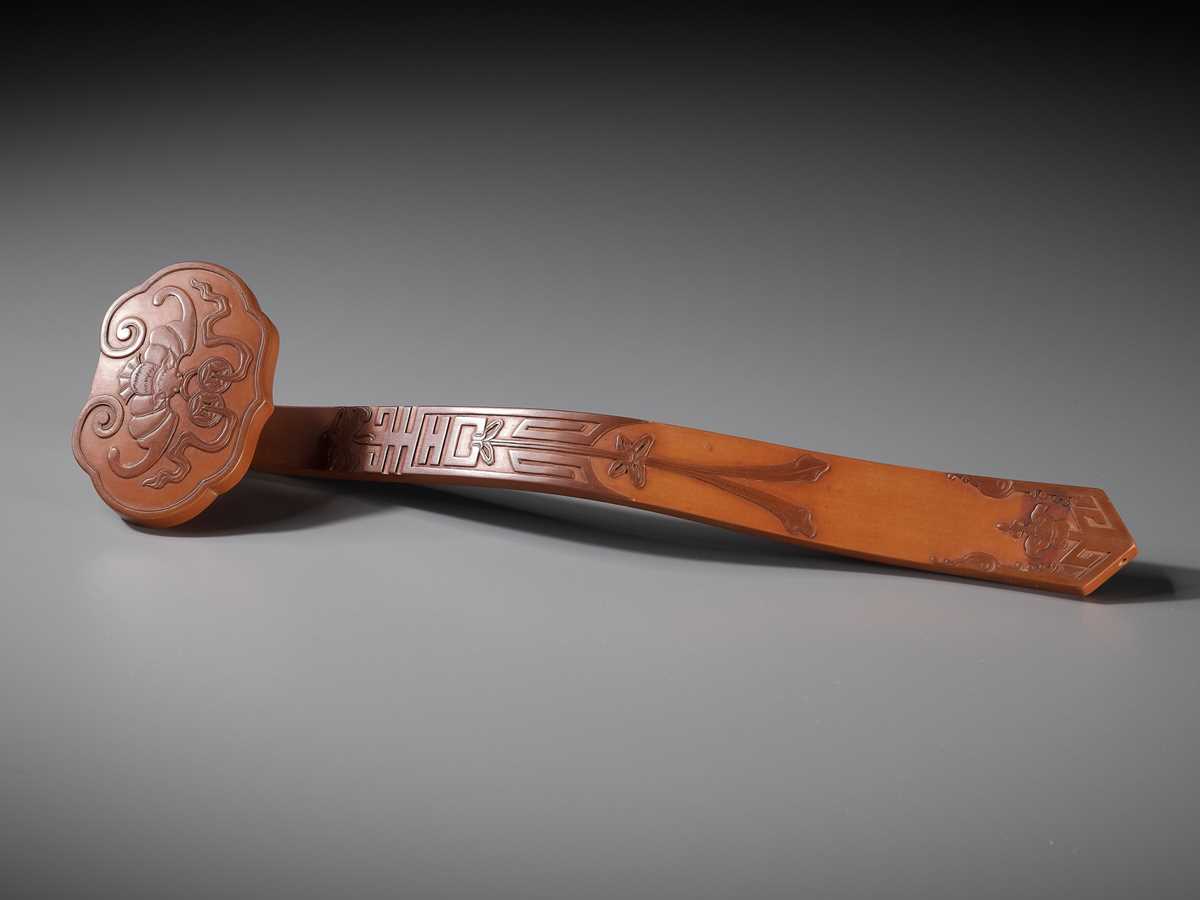1st Mar, 2024 10:00
The No Reserve Dragon Sale
4
AN EXTREMELY RARE AND FINE BAMBOO-VENEER RUYI SCEPTRE, QIANLONG PERIOD, IMPERIALLY INSCRIBED WITH A POEM COMPOSED IN THE BINGZI YEAR (1756)
乾隆時期罕見御題竹如意
Sold for €5,850
including Buyer's Premium
Please note this Lot is to be sold at No Reserve. 本拍品不設底價
Inscription: The poem Zhu ruyi, written by the Qianlong Emperor, is meticulously incised in three columns to the reverse. The inscription's quality is remarkably high, executed with a precision that only the Imperial workshops in Beijing were capable of achieving.
‘My literary mind is that of the rhapsodies of Deyu,
and my sense of Chan is that of the poetry of Jiaoran.
Moreover, I possess perfectly natural joints,
and am wholly free of protruding branches.
The magic arts of Luo Gongyuan are but fantasies after all,
but the gift of Sengshao is truly a suitable thing.
I only like it where pure conversation occurs,
as when I meet with noblemen.’
‘Qianlong yuti’ (Imperial composition of the Qianlong Emperor)
China, 1756-1795. The scepter shows a smooth, golden bamboo-veneer surface and is carved in two parts with an arched shaft terminating in a large head decorated with a flying bat suspending two cash coins (wu zhu) linked together by a ribbon in its mouth. The shaft is decorated with a stylized Shou character suspended from a chime and tied with a ribbon hanging from the character’s center, the base of the shaft with a central lotus bloom surrounded by ruyi and key-fret designs.
Provenance: From an old private collection in the United Kingdom, acquired by the previous owner’s grandparents and thence by descent in the same family.
Condition: Superb condition with expected minor old wear, minuscule flaking, some natural age cracks barely visible to the naked eye, and occasional light surface scratches. Naturally grown golden-brown patina overall.
Weight: 80.1 g
Dimensions: Length 32.7 cm
Please click here to read the full description
The poem inscribed on the present scepter is titled Zhu ruyi ('The Bamboo Ruyi Sceptre'), recorded in Qianlong yuzhi shiji ('Collected Poems of the Qianlong Emperor'), vol. 2, 63 juan, and dated between the 10th day of the 4th month and the 28th day of the 4th month of the bingzi year (equivalent to 1756).
In his poem, Qianlong refers to Li Deyu (787-850) from the Tang dynasty who served as prime minister. Li Deyu was a politician but was also a famous writer of prose and poetry. He wrote beautiful rhapsodies known as fu which the emperor praises in the poem as wenxin or 'literary minded.' This was likely meant as a pun, playing off the word wenxin which means 'the core of my grain.' The pun implies that the bamboo is robust and strong just like Li's epic poems. Another play on words occurs when the emperor refers to Li’s eminently high moral principles (dajie) by using the expression tianran jie (natural joints), referring to Li's 'heavenly endowed moral integrity'.
Jiaoran (730-799), the second reference in Qianlong’s poem, was a poet monk from Changcheng in the Zhejiang province, who was also known by his secular name Xie Zhou. He was deeply influenced by Daoist, Buddhist, and Confucian traditions, and he lived in the Miaoxi temple on Xu Mountain. He became famous for his literary criticism and was a key participator in the Classical Prose Movement of the late Tang dynasty. Jiaoran conveyed the meaning of Chan (Zen) Buddhism in his work, and his poems pontificate on the truth derived from consciousness, contemplation and enlightenment. Qianlong, a devote Buddhist, spent many hours in his study reading the poems of Jiaoran and associated himself with the notion that his 'sense of Chan' was on the same level as his.
The third historical figure mentioned by Qianlong in this poem is Luo Gongyuan, a Daoist priest, who according to legends used his magic to help Emperor Xuangzong (712-755) meet the beautiful Consort Yang Guifei in his afterlife. In the poem, Qianlong also mentions the priest Sengshao, who is known for compiling the work Hualin Fodian Zhongjing Mulu (The Catalogue of the Scriptures Kept in the Buddha Hall of Hualin Palace) in 513 on the orders of the Wu emperor of the Liang dynasty. He was a learned monk who lived in recluse and gave up his hermitage which was reconstructed to be a Buddhist temple. Qianlong refers to this temple constructed on the site of Sengshao’s hermitage when he writes 'the gift of Sengshao,' which is the famous Qixia si (Perched among Rosy Clouds Temple).
By comparing himself to famous figures in antiquity, Qianlong was setting an example for himself and for others to follow. He wrote that his preference was 'pure conversation', insinuating that Li Deyu and the others were men who were free from the taint of the mundane, political, and personal ambitions and all worldly concerns that he himself had to handle on daily basis.
Bamboo veneer, or zhuhuang, was a technique developed in Jiangxi province in the mid-Qianlong period and taken up by the Palace Workshops, thereafter remaining popular at the Court well into the 19th century. It required tremendous skill, using the inner layer from the cortex of the bamboo, which was resistant to insects, to create the veneer. This was then decoratively applied to a base form, usually also made of bamboo, and subsequently carved.
The bat holding two cash coins creates a visual pun. The word for bat (fu) sounds like the word for happiness, while the word for coin is a homophonous link to the word ‘before’ or ‘in front of.’ These homophones are meant to be interpreted as the blessing ‘happiness before your eyes.’
Literature comparison:
Compare a closely related bamboo-veneer scepter donated by Florence and Herbert Irving with the identical Qianlong poem inscribed on the reverse, 34.9 cm long, dated to the mid-18th century, in the Metropolitan Museum of Art, accession number 2015.500.6.40, exhibited in Masters and Masterpieces: Chinese Art from the Florence and Herbert Irving Collection, January 30, 2021-June 5, 2022.
Auction result comparison:
Type: Closely related
Auction: Sotheby’s Hong Kong, 7 April 2010, lot 1728
Price: HKD 15,780,000 or approx. EUR 2,624,000 converted and adjusted for inflation at the time of writing
Description: An imperially inscribed bamboo-veneer ruyi-scepter Qianlong period, poem composed in the Bingzi year (1756)
Expert remark: Compare the poem, which is identical to the one written on the present scepter. This ruyi was assumed to have been the original ruyi scepter that served Qianlong as the inspiration for his poem Zhu ruyi. However, this assumption is clearly refuted by the existence of the present scepter as well as other examples listed.
Auction result comparison:
Type: Closely related
Auction: Christie’s Hong Kong, 30 November 2016, lot 3224
Estimate: HKD 7,000,000 or approx. EUR 926,000 converted and adjusted for inflation at the time of writing
Description: An inscribed bamboo veneer ruyi scepter with a poem by the Qianlong Emperor, Qianlong period
Expert remark: Compare the closely related form, technique, and material, as well as the identical poem inscribed on the reverse. Note the size (45 cm).
Auction result comparison:
Type: Closely related
Auction: Beijing Poly International Auction, 29 November 2010, lot 4797
Price: RMB 5,600,00 or approx. EUR 982,000 converted and adjusted for inflation at the time of writing
Description: An imperial bamboo-veneer ruyi with an imperial poem by the Qianlong Emperor, Qianlong period
Expert remark: Compare the closely related form, technique, and material, as well as the identical poem inscribed on the reverse. Note the size (35 cm).
点此阅读中文翻译 (Chinese Translation)
乾隆時期罕見御題竹如意
中國,1756-1795年。如意體形寬長,雲頭形如意首碩大飽滿,配以彎曲起伏的長柄,優美流暢。首部及柄部、尾部的正反面以去皮之竹肌為地,在竹皮上淺浮雕出雕刻著嘴裏叼著錢幣的展翅蝙蝠,壽字紋,紋飾精美,寓意吉祥如意。柄底部有一朵中央蓮花,周圍環繞著如意和雷紋。背面刻乾隆御詩一首。工致處纖毫畢現,下刀力度均勻,所有留青紋飾的表現層次一致,技術難度極大。數百年的歲月流逝,器表已逐漸老化形成潤澤的包漿,竹纖維肌理清晰可見。包漿呈琥珀紅色,青筠處顏色較淺,竹肌處較深。
款識:文心德裕賦,禪意皎然詩。尚有天然節,全無側出枝。羅公術終幻,僧紹賜真宜。獨喜清談處,如逢君子時。乾隆御題
來源:英國私人舊藏,是現任藏家的爺爺所購,在同一家族保存至今。
品相:狀況極佳,有輕微磨損、微小剝落、一些肉眼幾乎看不見的自然老化裂紋,以及局部輕微表面劃痕。
重量:80.1克
尺寸:長32.7 厘米
這首詩名爲《竹如意》,收錄於《乾隆御製詩集》二集,卷六十三,寫於丙子年(1756)四月初十至廿八之間。
詩中提及的“德裕”是指唐朝宰相兼詩人李德裕 (787-850) ,兼擅散文詩賦。乾隆稱其賦別具“文心”(人文之心),同時以“文竹之心”比喻李德裕的賦,并以竹如意的“天然節”喻其“大節”,稱頌他的高風亮節。
御詩中提到的僧人皎然(730-799) 來自浙江長城,法名謝晝。他通諳儒釋道三教,曾居吳興杼山妙喜寺。晚唐時,他在文評界享有名氣,並參與當時的古文運動。皎然以禪入文,評論佛教中的証、觀、覺。乾隆篤信佛教,常閱皎然之詩,認爲兩人“禪意“相近。
乾隆詩中也提及唐代道士羅公遠,相傳他曾以仙法助唐玄宗 (712-755) 與楊貴妃在往生相見。題詩提及的另一位修士僧紹,潛心向佛,於513年奉梁武帝撰寫《華林佛殿眾經目錄》,曾捨宅為寺,后命為”栖霞寺“,應爲乾隆詩中提及僧紹所賜之物。
乾隆御先賢高僧相提并論,意在以古為鏡,鋻己照人。他以”獨喜清談処“一句作引,頌揚李德裕等人不拘于俗、不畏强權、不顧私利,憂國憂民,當爲”君子“,借此警示爲君為臣者應有的處世治國之道。
竹簧是一大發明與創造,至乾隆中期在江西地區竹簧工藝達到高峰,並被宮廷御作坊採用,此後一直在清廷中流行到 19 世紀。其製作工藝相當複雜,將竹子留下薄層的竹簧,經過煮、曬、壓平後,膠合在木胎上,然後磨光,再在上面刻飾各種圖案。
文獻比較:
比較一件非常相近的十八世紀乾隆詩文竹簧如意,長34.9 釐米,Florence和Herbert Irving捐贈至大都會藝術博物館,館藏編號2015.500.6.40,曾展覽於《Masters and Masterpieces: Chinese Art from the Florence and Herbert Irving Collection》,2021年1月 30日至2022年6月 5日。比較一件非常相近的乾隆時期詩文竹簧如意,長35.2 釐米,亦是Irving夫婦捐贈於大都會藝術博物館並展出,館藏編號2015.500.6.40。
拍賣結果比較:
形制:非常相近
拍賣:香港蘇富比,2010年4月7日,lot 1728
價格:HKD 15,780,000(相當於今日EUR 2,624,000)
描述:丙子年乾隆詩文御製竹簧如意
專家評論:比較詩,與本權杖上所寫的詩一模一樣。這件如意被認為是乾隆皇帝所有,作為他的詩《竹如意》的靈感來源。然而,這個假設已經被本拍品以及其他如意的存在所駁斥了。
拍賣結果比較:
形制:非常相近
拍賣:香港佳士得,2016年11月30日,lot 3224
估價:HKD 7,000,000(相當於今日EUR 926,000)
描述:清乾隆御題詩竹黃五福捧壽如意
專家評論:比較非常相近的外形、技術和材質,以及相同的詩文。請注意尺寸 (45 釐米)。
拍賣結果比較:
形制:非常相近
拍賣:北京保利,2010年11月29日,lot 4797
價格:RMB 5,600,00(相當於今日EUR 982,000)
描述:清乾隆御製竹黃禦制詩福壽如意
專家評論:比較非常相近的外形、技術和材質,以及相同的詩文。請注意尺寸 (35 釐米)。
Please note this Lot is to be sold at No Reserve. 本拍品不設底價
Inscription: The poem Zhu ruyi, written by the Qianlong Emperor, is meticulously incised in three columns to the reverse. The inscription's quality is remarkably high, executed with a precision that only the Imperial workshops in Beijing were capable of achieving.
‘My literary mind is that of the rhapsodies of Deyu,
and my sense of Chan is that of the poetry of Jiaoran.
Moreover, I possess perfectly natural joints,
and am wholly free of protruding branches.
The magic arts of Luo Gongyuan are but fantasies after all,
but the gift of Sengshao is truly a suitable thing.
I only like it where pure conversation occurs,
as when I meet with noblemen.’
‘Qianlong yuti’ (Imperial composition of the Qianlong Emperor)
China, 1756-1795. The scepter shows a smooth, golden bamboo-veneer surface and is carved in two parts with an arched shaft terminating in a large head decorated with a flying bat suspending two cash coins (wu zhu) linked together by a ribbon in its mouth. The shaft is decorated with a stylized Shou character suspended from a chime and tied with a ribbon hanging from the character’s center, the base of the shaft with a central lotus bloom surrounded by ruyi and key-fret designs.
Provenance: From an old private collection in the United Kingdom, acquired by the previous owner’s grandparents and thence by descent in the same family.
Condition: Superb condition with expected minor old wear, minuscule flaking, some natural age cracks barely visible to the naked eye, and occasional light surface scratches. Naturally grown golden-brown patina overall.
Weight: 80.1 g
Dimensions: Length 32.7 cm
Please click here to read the full description
The poem inscribed on the present scepter is titled Zhu ruyi ('The Bamboo Ruyi Sceptre'), recorded in Qianlong yuzhi shiji ('Collected Poems of the Qianlong Emperor'), vol. 2, 63 juan, and dated between the 10th day of the 4th month and the 28th day of the 4th month of the bingzi year (equivalent to 1756).
In his poem, Qianlong refers to Li Deyu (787-850) from the Tang dynasty who served as prime minister. Li Deyu was a politician but was also a famous writer of prose and poetry. He wrote beautiful rhapsodies known as fu which the emperor praises in the poem as wenxin or 'literary minded.' This was likely meant as a pun, playing off the word wenxin which means 'the core of my grain.' The pun implies that the bamboo is robust and strong just like Li's epic poems. Another play on words occurs when the emperor refers to Li’s eminently high moral principles (dajie) by using the expression tianran jie (natural joints), referring to Li's 'heavenly endowed moral integrity'.
Jiaoran (730-799), the second reference in Qianlong’s poem, was a poet monk from Changcheng in the Zhejiang province, who was also known by his secular name Xie Zhou. He was deeply influenced by Daoist, Buddhist, and Confucian traditions, and he lived in the Miaoxi temple on Xu Mountain. He became famous for his literary criticism and was a key participator in the Classical Prose Movement of the late Tang dynasty. Jiaoran conveyed the meaning of Chan (Zen) Buddhism in his work, and his poems pontificate on the truth derived from consciousness, contemplation and enlightenment. Qianlong, a devote Buddhist, spent many hours in his study reading the poems of Jiaoran and associated himself with the notion that his 'sense of Chan' was on the same level as his.
The third historical figure mentioned by Qianlong in this poem is Luo Gongyuan, a Daoist priest, who according to legends used his magic to help Emperor Xuangzong (712-755) meet the beautiful Consort Yang Guifei in his afterlife. In the poem, Qianlong also mentions the priest Sengshao, who is known for compiling the work Hualin Fodian Zhongjing Mulu (The Catalogue of the Scriptures Kept in the Buddha Hall of Hualin Palace) in 513 on the orders of the Wu emperor of the Liang dynasty. He was a learned monk who lived in recluse and gave up his hermitage which was reconstructed to be a Buddhist temple. Qianlong refers to this temple constructed on the site of Sengshao’s hermitage when he writes 'the gift of Sengshao,' which is the famous Qixia si (Perched among Rosy Clouds Temple).
By comparing himself to famous figures in antiquity, Qianlong was setting an example for himself and for others to follow. He wrote that his preference was 'pure conversation', insinuating that Li Deyu and the others were men who were free from the taint of the mundane, political, and personal ambitions and all worldly concerns that he himself had to handle on daily basis.
Bamboo veneer, or zhuhuang, was a technique developed in Jiangxi province in the mid-Qianlong period and taken up by the Palace Workshops, thereafter remaining popular at the Court well into the 19th century. It required tremendous skill, using the inner layer from the cortex of the bamboo, which was resistant to insects, to create the veneer. This was then decoratively applied to a base form, usually also made of bamboo, and subsequently carved.
The bat holding two cash coins creates a visual pun. The word for bat (fu) sounds like the word for happiness, while the word for coin is a homophonous link to the word ‘before’ or ‘in front of.’ These homophones are meant to be interpreted as the blessing ‘happiness before your eyes.’
Literature comparison:
Compare a closely related bamboo-veneer scepter donated by Florence and Herbert Irving with the identical Qianlong poem inscribed on the reverse, 34.9 cm long, dated to the mid-18th century, in the Metropolitan Museum of Art, accession number 2015.500.6.40, exhibited in Masters and Masterpieces: Chinese Art from the Florence and Herbert Irving Collection, January 30, 2021-June 5, 2022.
Auction result comparison:
Type: Closely related
Auction: Sotheby’s Hong Kong, 7 April 2010, lot 1728
Price: HKD 15,780,000 or approx. EUR 2,624,000 converted and adjusted for inflation at the time of writing
Description: An imperially inscribed bamboo-veneer ruyi-scepter Qianlong period, poem composed in the Bingzi year (1756)
Expert remark: Compare the poem, which is identical to the one written on the present scepter. This ruyi was assumed to have been the original ruyi scepter that served Qianlong as the inspiration for his poem Zhu ruyi. However, this assumption is clearly refuted by the existence of the present scepter as well as other examples listed.
Auction result comparison:
Type: Closely related
Auction: Christie’s Hong Kong, 30 November 2016, lot 3224
Estimate: HKD 7,000,000 or approx. EUR 926,000 converted and adjusted for inflation at the time of writing
Description: An inscribed bamboo veneer ruyi scepter with a poem by the Qianlong Emperor, Qianlong period
Expert remark: Compare the closely related form, technique, and material, as well as the identical poem inscribed on the reverse. Note the size (45 cm).
Auction result comparison:
Type: Closely related
Auction: Beijing Poly International Auction, 29 November 2010, lot 4797
Price: RMB 5,600,00 or approx. EUR 982,000 converted and adjusted for inflation at the time of writing
Description: An imperial bamboo-veneer ruyi with an imperial poem by the Qianlong Emperor, Qianlong period
Expert remark: Compare the closely related form, technique, and material, as well as the identical poem inscribed on the reverse. Note the size (35 cm).
点此阅读中文翻译 (Chinese Translation)
乾隆時期罕見御題竹如意
中國,1756-1795年。如意體形寬長,雲頭形如意首碩大飽滿,配以彎曲起伏的長柄,優美流暢。首部及柄部、尾部的正反面以去皮之竹肌為地,在竹皮上淺浮雕出雕刻著嘴裏叼著錢幣的展翅蝙蝠,壽字紋,紋飾精美,寓意吉祥如意。柄底部有一朵中央蓮花,周圍環繞著如意和雷紋。背面刻乾隆御詩一首。工致處纖毫畢現,下刀力度均勻,所有留青紋飾的表現層次一致,技術難度極大。數百年的歲月流逝,器表已逐漸老化形成潤澤的包漿,竹纖維肌理清晰可見。包漿呈琥珀紅色,青筠處顏色較淺,竹肌處較深。
款識:文心德裕賦,禪意皎然詩。尚有天然節,全無側出枝。羅公術終幻,僧紹賜真宜。獨喜清談處,如逢君子時。乾隆御題
來源:英國私人舊藏,是現任藏家的爺爺所購,在同一家族保存至今。
品相:狀況極佳,有輕微磨損、微小剝落、一些肉眼幾乎看不見的自然老化裂紋,以及局部輕微表面劃痕。
重量:80.1克
尺寸:長32.7 厘米
這首詩名爲《竹如意》,收錄於《乾隆御製詩集》二集,卷六十三,寫於丙子年(1756)四月初十至廿八之間。
詩中提及的“德裕”是指唐朝宰相兼詩人李德裕 (787-850) ,兼擅散文詩賦。乾隆稱其賦別具“文心”(人文之心),同時以“文竹之心”比喻李德裕的賦,并以竹如意的“天然節”喻其“大節”,稱頌他的高風亮節。
御詩中提到的僧人皎然(730-799) 來自浙江長城,法名謝晝。他通諳儒釋道三教,曾居吳興杼山妙喜寺。晚唐時,他在文評界享有名氣,並參與當時的古文運動。皎然以禪入文,評論佛教中的証、觀、覺。乾隆篤信佛教,常閱皎然之詩,認爲兩人“禪意“相近。
乾隆詩中也提及唐代道士羅公遠,相傳他曾以仙法助唐玄宗 (712-755) 與楊貴妃在往生相見。題詩提及的另一位修士僧紹,潛心向佛,於513年奉梁武帝撰寫《華林佛殿眾經目錄》,曾捨宅為寺,后命為”栖霞寺“,應爲乾隆詩中提及僧紹所賜之物。
乾隆御先賢高僧相提并論,意在以古為鏡,鋻己照人。他以”獨喜清談処“一句作引,頌揚李德裕等人不拘于俗、不畏强權、不顧私利,憂國憂民,當爲”君子“,借此警示爲君為臣者應有的處世治國之道。
竹簧是一大發明與創造,至乾隆中期在江西地區竹簧工藝達到高峰,並被宮廷御作坊採用,此後一直在清廷中流行到 19 世紀。其製作工藝相當複雜,將竹子留下薄層的竹簧,經過煮、曬、壓平後,膠合在木胎上,然後磨光,再在上面刻飾各種圖案。
文獻比較:
比較一件非常相近的十八世紀乾隆詩文竹簧如意,長34.9 釐米,Florence和Herbert Irving捐贈至大都會藝術博物館,館藏編號2015.500.6.40,曾展覽於《Masters and Masterpieces: Chinese Art from the Florence and Herbert Irving Collection》,2021年1月 30日至2022年6月 5日。比較一件非常相近的乾隆時期詩文竹簧如意,長35.2 釐米,亦是Irving夫婦捐贈於大都會藝術博物館並展出,館藏編號2015.500.6.40。
拍賣結果比較:
形制:非常相近
拍賣:香港蘇富比,2010年4月7日,lot 1728
價格:HKD 15,780,000(相當於今日EUR 2,624,000)
描述:丙子年乾隆詩文御製竹簧如意
專家評論:比較詩,與本權杖上所寫的詩一模一樣。這件如意被認為是乾隆皇帝所有,作為他的詩《竹如意》的靈感來源。然而,這個假設已經被本拍品以及其他如意的存在所駁斥了。
拍賣結果比較:
形制:非常相近
拍賣:香港佳士得,2016年11月30日,lot 3224
估價:HKD 7,000,000(相當於今日EUR 926,000)
描述:清乾隆御題詩竹黃五福捧壽如意
專家評論:比較非常相近的外形、技術和材質,以及相同的詩文。請注意尺寸 (45 釐米)。
拍賣結果比較:
形制:非常相近
拍賣:北京保利,2010年11月29日,lot 4797
價格:RMB 5,600,00(相當於今日EUR 982,000)
描述:清乾隆御製竹黃禦制詩福壽如意
專家評論:比較非常相近的外形、技術和材質,以及相同的詩文。請注意尺寸 (35 釐米)。
Zacke Live Online Bidding
Our online bidding platform makes it easier than ever to bid in our auctions! When you bid through our website, you can take advantage of our premium buyer's terms without incurring any additional online bidding surcharges.
To bid live online, you'll need to create an online account. Once your account is created and your identity is verified, you can register to bid in an auction up to 12 hours before the auction begins.
Intended Spend and Bid Limits
When you register to bid in an online auction, you will need to share your intended maximum spending budget for the auction. We will then review your intended spend and set a bid limit for you. Once you have pre-registered for a live online auction, you can see your intended spend and bid limit by going to 'Account Settings' and clicking on 'Live Bidding Registrations'.
Your bid limit will be the maximum amount you can bid during the auction. Your bid limit is for the hammer price and is not affected by the buyer’s premium and VAT. For example, if you have a bid limit of €1,000 and place two winning bids for €300 and €200, then you will only be able to bid €500 for the rest of the auction. If you try to place a bid that is higher than €500, you will not be able to do so.
Online Absentee and Telephone Bids
You can now leave absentee and telephone bids on our website!
Absentee Bidding
Once you've created an account and your identity is verified, you can leave your absentee bid directly on the lot page. We will contact you when your bids have been confirmed.
Telephone Bidding
Once you've created an account and your identity is verified, you can leave telephone bids online. We will contact you when your bids have been confirmed.
Classic Absentee and Telephone Bidding Form
You can still submit absentee and telephone bids by email or fax if you prefer. Simply fill out the Absentee Bidding/Telephone bidding form and return it to us by email at office@zacke.at or by fax at +43 (1) 532 04 52 20. You can download the PDF from our Upcoming Auctions page.
How-To Guides
How to Create Your Personal Zacke Account
How to Register to Bid on Zacke Live
How to Leave Absentee Bids Online
How to Leave Telephone Bids Online
中文版本的操作指南
创建新账号
注册Zacke Live在线直播竞拍(免平台费)
缺席投标和电话投标
Third-Party Bidding
We partner with best-in-class third-party partners to make it easy for you to bid online in the channel of your choice. Please note that if you bid with one of our third-party online partners, then there will be a live bidding surcharge on top of your final purchase price. You can find all of our fees here. Here's a full list of our third-party partners:
- 51 Bid Live
- EpaiLive
- ArtFoxLive
- Invaluable
- LiveAuctioneers
- the-saleroom
- lot-tissimo
- Drouot
Please note that we place different auctions on different platforms. For example, in general, we only place Chinese art auctions on 51 Bid Live.
Bidding in Person
You must register to bid in person and will be assigned a paddle at the auction. Please contact us at office@zacke.at or +43 (1) 532 04 52 for the latest local health and safety guidelines.
